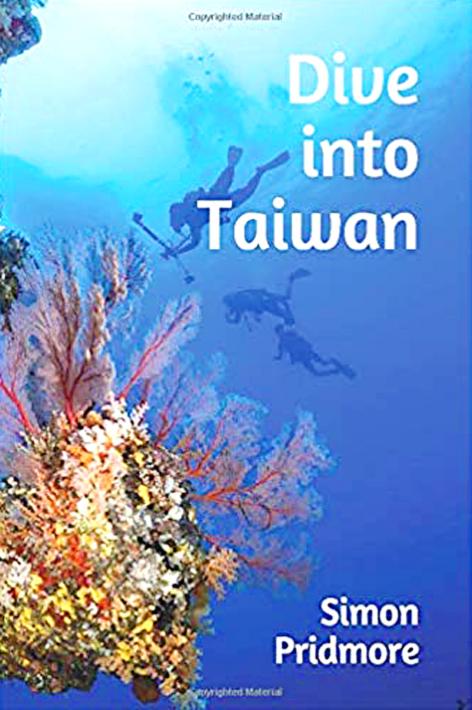This is the first comprehensive guide to scuba diving in Taiwan ever published, and it has the feel of an instant classic. Taiwan is not one of the world’s premier scuba destinations, says Simon Pridmore, but it has many diving attractions and shouldn’t be ignored.
The book opens with an admirably comprehensive introduction to Taiwan’s geography, history, languages and access procedures. These sections couldn’t be clearer or more helpful. Consider this, for example, on driving a car on the island: “If you are in a car and you hit someone on a scooter, it will be your fault even if they crashed into you. This is not because you are a foreigner or a visitor; it is because you are in a car. This is just how it is.”
The reason Taiwan has spectacular diving sites, Pridmore explains, is the kuroshio, or “dark tide,” a Pacific equivalent of the North Atlantic’s Gulf stream. The name derives from the “deep, dark, clear ultramarine blue” of the affected oceans — a paradise, needless to say, for scuba divers — and it flows up the east coast of Taiwan towards Japan.

The first of the six diving sites Pridmore deals with is on the north-east coast, a mere hour’s drive from Taipei at Badouzi (八斗子). Notable here are the Wanghaixiang bay (望海巷) area (including Secret Garden and Secret Garden 2), the Longdong bay (龍洞) area (also popular with rock-climbers), and a site called 82.5km for its roadside marker number on the North Coast Highway. In addition, there’s Turtle Island off the coast of Yilan, an underwater volcanic vent and Taiwan’s only active volcano.
Next comes Penghu (澎壺). Most of the diving here is from a boat, and among the highlights are an underwater postbox and a sunken wreck. Also notable is Wolf East (東吉之狼), where “a giant school of very large, fat yellowtail barracuda” enjoy the current off the south of Dongjiyu (東吉嶼). Pridmore claims this may be one of your best diving experiences in Taiwan.
Also notable in this area are the Dongjiyu Lavender Fields (also attractive to snorkelers) and the Xijiyu Basalt Ridge. As always, the author is hugely informative on things to do above water in the islands’ towns and villages.
Then, very close to Kaohsiung, is the island of Siaoliouciou (小琉球), the only place in Taiwan’s waters, we’re informed, where you can enjoy warm-water diving all the year round. Here more shipwrecks and a “beauty cave” form the main attractions.
After surveying the diving attractions of Hengchun (恆春), close to Kenting (墾丁), plus a quick look at Taitung (not really a diving center), Pridmore moves on to Orchid Island (蘭嶼)and Green Island (綠島).
After summarizing Orchid Island’s flying-fish and nuclear waste phenomena, plus the history of the Tao Aborigines, the book goes on to look at the diving sites, choosing the Badai Bay wreck (八代灣) and the Airport Perimeter Reef (機場外礁) as the best two, both with excellent visibility. “On a blue-sky day,” the author writes, “from mid-morning onwards, these coral gardens will be glowing with clouds of small reef fish milling about and sparkling and shimmering in the sun.”
International divers, we’re told, will be pleased by the sight in Taiwan of species they have never encountered before, such as Shepard’s pygmy angelfish and firetail dottyback. And at Lady Rock (玉女岩) to the northwest of the island, where sea snakes are the main attraction, access is directly from the shore rather than by boat, as is common elsewhere in the area. The somewhat less dramatic Fire Reef is nearby.
Finally, Green Island. Its history as a penal colony is sketched in, but it’s quickly followed by the assertion that today the island’s “fringing reefs and vertiginous undersea pinnacles are a scuba diving dream come true.” Indeed, Green Island is often the only Taiwanese diving site newcomers have ever heard of. And despite problems of over-consumption of fish (Pridmore suggests the local authority follows Penghu’s environmentally-sensitive example), Green Island nonetheless boasts “the most sophisticated services in Taiwan for experienced sport divers.”
Shilang Bay (石朗) offers the most extensive opportunities for scuba divers and snorkelers alike. At Dabaisha (大白沙) nearby strong currents predominate, but even so its Chicken Reef should be “at the top of your list of must-dos for Green Island.”
A Green Island site that has become internationally famous is Gun Shui Bi (滾水鼻), straight out to sea from the hot springs at Zhaori (朝日). The reason for the fame is the appearance every January and February of schools of scalloped hammerhead sharks. But with the strong currents and open-sea location of the site, your access is subject to close scrutiny by dive operators, and even if you do get to go there you can’t reasonably expect more than a shadowy glimpse of these phenomenal creatures at a distance.
Pridmore concludes with a very wide range of topics such as emergency procedures, organizing a round-trip “safari” of different Taiwan sites, guides, diving companies and — at some length — Taiwanese food.
All in all, this book couldn’t be bettered. Its author has already three diving guides to various parts of Indonesia under his belt, plus more titles on diving in general. Taiwan, in short, is lucky to have gained his attention, plus his judgment that though scuba diving is relatively new here, it is developing at a considerable pace.
Lastly, huge praise must go to the photographer, Kyo Liu (劉守全). Almost all the photos are his, and they’re invariably superb.
This really is an astonishing book. I even found it difficult to stay at my desk writing this review, so strong was the temptation its pages constituted to get up and make for the great outdoors (so aptly named).
The colors the book evokes, and indeed contains, are themselves breath-taking, whether they’re of coral, fish, boats, or the temples overlooking the diving waters. The whole book is suffused with light, astonishing when so much of it focuses on the underwater. Dive into Taiwan is both a delight to hold and a pleasure to read, and without doubt will quickly become a bible for Taiwan’s scuba divers. Very highly recommended.

One of the biggest sore spots in Taiwan’s historical friendship with the US came in 1979 when US president Jimmy Carter broke off formal diplomatic relations with Taiwan’s Republic of China (ROC) government so that the US could establish relations with the People’s Republic of China (PRC). Taiwan’s derecognition came purely at China’s insistence, and the US took the deal. Retired American diplomat John Tkacik, who for almost decade surrounding that schism, from 1974 to 1982, worked in embassies in Taipei and Beijing and at the Taiwan Desk in Washington DC, recently argued in the Taipei Times that “President Carter’s derecognition

This year will go down in the history books. Taiwan faces enormous turmoil and uncertainty in the coming months. Which political parties are in a good position to handle big changes? All of the main parties are beset with challenges. Taking stock, this column examined the Taiwan People’s Party (TPP) (“Huang Kuo-chang’s choking the life out of the TPP,” May 28, page 12), the Democratic Progressive Party (DPP) (“Challenges amid choppy waters for the DPP,” June 14, page 12) and the Chinese Nationalist Party (KMT) (“KMT struggles to seize opportunities as ‘interesting times’ loom,” June 20, page 11). Times like these can

Dr. Y. Tony Yang, Associate Dean of Health Policy and Population Science at George Washington University, argued last week in a piece for the Taipei Times about former president Ma Ying-jeou (馬英九) leading a student delegation to the People’s Republic of China (PRC) that, “The real question is not whether Ma’s visit helps or hurts Taiwan — it is why Taiwan lacks a sophisticated, multi-track approach to one of the most complex geopolitical relationships in the world” (“Ma’s Visit, DPP’s Blind Spot,” June 18, page 8). Yang contends that the Democratic Progressive Party (DPP) has a blind spot: “By treating any

You can tell a lot about a generation from the contents of their cool box: nowadays the barbecue ice bucket is likely to be filled with hard seltzers, non-alcoholic beers and fluorescent BuzzBallz — a particular favorite among Gen Z. Two decades ago, it was WKD, Bacardi Breezers and the odd Smirnoff Ice bobbing in a puddle of melted ice. And while nostalgia may have brought back some alcopops, the new wave of ready-to-drink (RTD) options look and taste noticeably different. It is not just the drinks that have changed, but drinking habits too, driven in part by more health-conscious consumers and